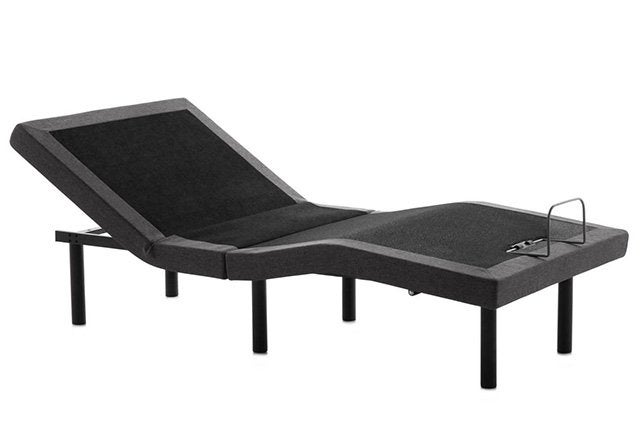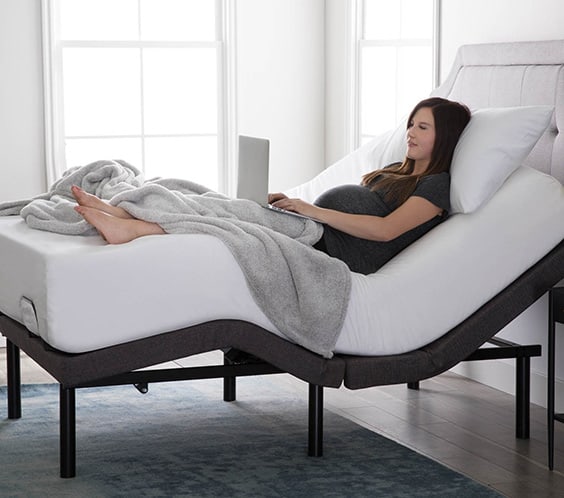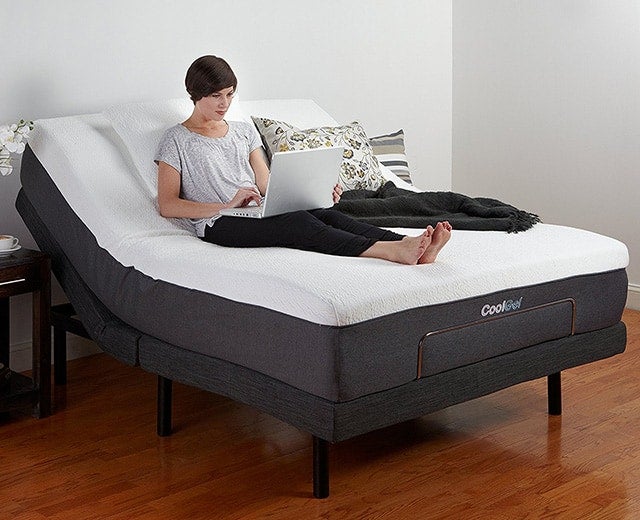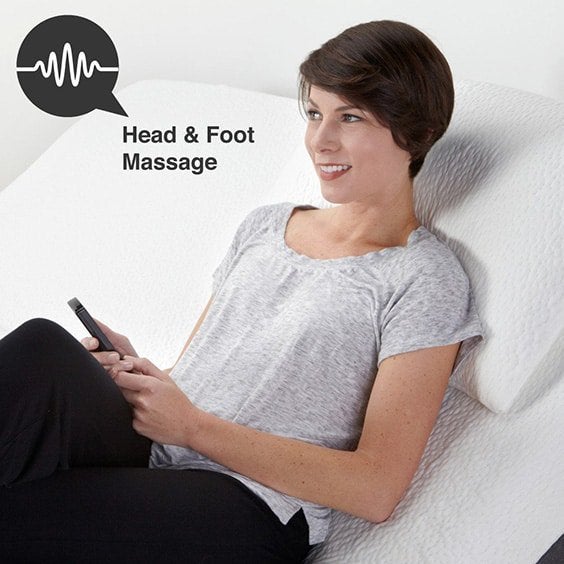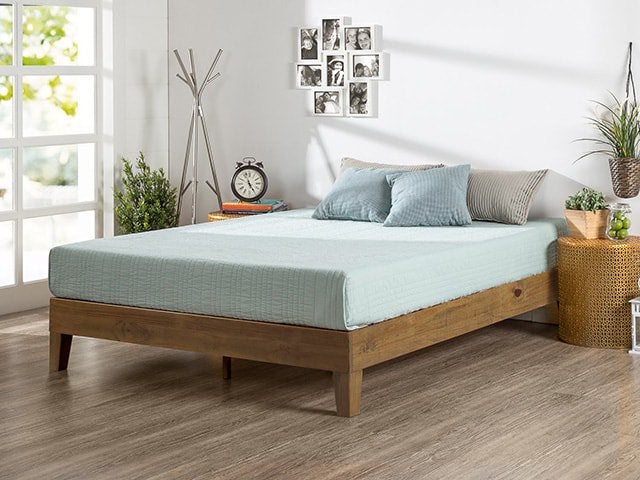Previously considered a thing for hospitals and clinics, adjustable beds have seen a surge in popularity in recent years with many manufacturers adopting them and offering them with their high-end mattresses. Ordinary beds are still the same deal while adjustable beds are seen offering so much more. Thus, people are starting to debate the choice of adjustable bed vs regular bed.
I’ve written this post to break down the qualities, limitations, and considerations associated with both fixtures. It will hopefully help you decide which of the two is better suited to your needs.
What is an Adjustable Bed?
This is probably obvious, but if there’s any doubt, a standard modern adjustable bed is a bed consisting of a combination of three-part adjustable bases that can be independently lowered and raised at will. It was originally developed in the early twentieth century and used in healthcare institutes because of its ability to enhance the oxygen and blood flow of patients while recovering from ailments or surgeries.
By the middle of the twentieth century, manufacturers began to catch on to the fact that the same comfort and convenience could be extended to healthy consumers living in their homes. Thus, the present day adjustable bed came into being, and in its current state, it is a highly luxurious commodity with models geared towards a diverse range of consumer segments.
Pros
- Better pain relief and recovery.
- Better chance of achieving a comfortable resting position.
- Allows sitting or leaning in a more convenient, relaxed manner.
- Split options let you relax independently from your partner.
- Modern options have amenities such as USB ports and massagers.
Cons
- Expensive.
- More moving parts means a greater chance of breakdown.
- Require a compatible mattress.
- Moving parts might cause injury if handled improperly.
What are the Benefits of Getting an Adjustable Bed?
Since this was the first use these beds saw, it is only fair to discuss the health benefits first. Lying on a regular bed, especially if you have to do it for extended periods of time (e.g. if you’re sick or injured), can lead to a whole host of issues – including swelling on your legs and feet, acid reflux, back pain or soreness, pressure ulcers, and sluggish healing.
This is because your circulation and respiration become less than ideal if you’re lying flat on your back, and your bones begin to put stress on your flesh in the same spots. An adjustable bed lets you modify your oxygen intake and blood flow by inclining its segments so that you’re technically not lying parallel to the floor.
This changes the way gravity acts on your body, and by extension, the way the various parts of your body are supported, and how oxygen-rich blood is supplied to your vital organs.
Examples include the Fowler’s position which is used by healthcare experts to improve breathing and aid healing after surgeries, and the ‘Zero Gravity’ position where your head is partly elevated, and your feet are raised higher than your heart resulting in considerable reduction in back pain and boosted blood flow.
Comfort and Convenience Benefits
Getting out of bed, so you can grab a quick bite or watch your favorite TV show in the lounge can seem like a chore at times – with an adjustable bed, you can do all this from the comfort of your bedroom as you can adjust the positions of its platforms to make you sit upright, lean slightly, and so on.
Higher end models may even come with massage options – the vibrating action of the massager relaxes stiff muscles and improves blood flow, and this is without you having to pay money at a pricey spa each time you want the treatment. Its USB charging capability is often included with pricier models, so you won’t even have to move to charge your phone!
Some adjustable beds are available as split variants where one half of the bed can be operated separately from the other. This gives you the freedom to customize your sleeping experience without having to compromise with your partner.
Should I Get an Adjustable Bed?
Does your budget allow it?
If you’ve got a legitimate health concern like chronic back pain or an injury that compels you to stay in bed for extended periods of time, an adjustable bed will be a wise decision if your budget allows it. If not, you could always combine a regular bed with a decent pain relieving mattress to get similar (naturally, not identical) results.
Getting an adjustable bed simply for luxury is a purely discretionary matter and, again, is largely dependent on affordability.
Is your mattress compatible with it?
Bear in mind that a regular innerspring mattress will not be compatible with an adjustable bed unless the manufacturer expressly states it. Attempting to use it with such a bed will either damage the mattress or prevent the bed from working as intended.
Those who own a mattress made from latex or memory foam should be fine, though, since these materials are designed to be adaptable and are quite durable if made from the right density.
Is it compatible with your existing furniture?
Certain types of adjustable beds may not be compatible with your existing headboard and bedframe, or your general furniture layout may not accommodate the bed at all. Be certain to check the dimensions and operating mechanism of the adjustable bed that you plan on getting.
Are you able enough to set it up or move it on your own?
Because of the added functionality they bring, adjustable beds may need some assembly after delivery. Naturally, if you want to get an adjustable bed to deal with a bad back, you’ll have a hard time setting it up on your own because of the same issue! The problem is compounded if you frequently change houses.
In these situations, you may be better off getting a regular bed with a more comfortable contouring mattress that won’t take a lot of effort to set up or pack up when needed. Alternately, you could seek a company that offers delivery and assembly – it may cost extra, but it’s better to be safe than to end up hurting yourself trying to do it solo.
You’ll need a spare power connection to make it work (probably)
Most modern beds use electrical motors to achieve the motion that adjusts the positions of their platforms – these motors usually run on your main electricity so make sure you’ve got a spare wall socket handy for this purpose.
Remember that these electrical components make some noise unless you opt for an expensive option with ‘whisper-quiet’ operation.
A Regular Bed
The good old ordinary bed requires no introduction- it’s been around for centuries- and it doesn’t look like it’s going to be overtaken in popularity anytime soon.
Pros
- Inexpensive.
- Easier to assemble, disassemble, and move.
- Works with all mattresses.
- Requires minimal maintenance.
Cons
- Offers no adaptability to different sleep styles.
- All comfort or recovery responsibilities deferred to the mattress, comforter, paddings, etc.
What are the Benefits of a Regular Bed?
It doesn’t cost much
The biggest thing regular beds have got going for them is that they don’t require you to spend a lot of money. Naturally, if you’re going for a particular décor theme or want to splurge out on a highly luxurious bedroom, be ready to drop some dough, but the point is that it isn’t obligatory.
By spending less cash on a fixture that will be covered for the most part by bedding items (e.g. bedsheet, mattress, pillows etc.), you can spend better on more important things such as a mattress that offers you plenty of back support and pain relief.
This is an especially suitable choice for people who aren’t suffering from a condition that necessitates enhanced circulation or respiration that can only be achieved by an unconventional angle.
It doesn’t require a lot of maintenance
Since there aren’t any moving parts involved in a regular bed, you don’t have to worry about greasing any cogs or tightening any screws periodically. The bed will work fine year in and year out (depending of course on the kind of use you put it through!).
Easy to assemble and disassemble
Again, due to the lack of any mechanical components, it is quite easy to assemble an ordinary bed – at most you may have to tighten a few bolts and connect a few wedges. For simpler beds, there may not be any need for self-assembly at all!
Add to this, the fact that a regular bed can be moved around quite easily- an important consideration if your abode is temporary- you won’t have to worry about damaging any intricate mechanism if you accidentally bump the corner of the bed against a wall while carrying it.
This is worth noting for individuals who have an impairment that prevents them from assembling, collapsing, and moving the bed around as well as being unable to acquire any assistance.
Compatible with virtually any mattress
Mattresses are made to be placed on flat beds. In the majority of cases, if you get a new mattress, there isn’t any need to verify whether or not your current bed will work with it- is beyond a cursory look. If it’s flat and can support the base of the mattress adequately, it’ll be fine.
Should I Get a Regular Bed?
Consider your budget
As mentioned before, one of the primary attractions of a simple bed is its affordability. It is a low-risk investment that will most likely not have an appreciable impact on the comfort and support of your bed beyond providing a surface for the actual stuff that matters.
With adjustable beds, there’s always the risk that you may spend money on an expensive fixture that ends up not being what you expected – an annoyance that can take away psychological satisfaction from your purchase (which in turn can affect the comfort you physically feel from it).
If so desired, you can easily find regular second-hand beds, and in pretty good shape too. However, finding a functional adjustable second-hand bed can be challenging since the person selling it is likely doing so because it isn’t working like it’s supposed to!
Consider your necessity
There are certain health conditions that require you to lay in an inclined or modified position, and in that case, you should strongly consider an adjustable bed or something similar. If, however, your condition is mild enough to be dealt with by a simple bed that adjusts itself to the shape of your body, you can get away with using the right kind of mattress.
Of course, an adjustable bed will always help but, in many cases, can get the same results in terms of pain relief by carefully selecting the stuff that goes on the bed.
What kind of bedroom furniture do you already have?
As described above, adjustable beds may require you to reconfigure the rest of your bedroom around them because of the various transformations they can undergo- which makes most of them incompatible with bedrooms that are limited in space or have a fixed type of décor.
With regular beds, you’ll always have a huge collection to choose from regardless of the size and setup of your bedroom.
Adjustable Bed vs Regular Bed Comparison
| Adjustable Bed | Regular Bed |
|---|---|
| Expensive | Cheap |
| Actively aids healing and pain relief | No active health benefit |
| Supports you directly several different positions other than lying down | Can only lay down on it comfortably |
| May require complex assembly | Requires no or minimal assembly |
| Convenience options e.g. massager, USB charger | Usually no convenience options |
| Requires mains electricity to run | No power needed |
Conclusion
There isn’t really a clear winner in the adjustable bed vs regular bed argument. It is simply a matter of considering your own situation (according to the factors described above) and then deciding which option suits you better.
To put it in a nutshell, adjustable beds are luxurious, convenient, and do bring several potential health benefits with them but at a somewhat steep expense that may not be in everyone’s reach (or, indeed, not be necessary made for everyone).
In contrast, a regular bed, often than not, shuns luxury and convenience in favor of core functionality. It provides you with a stable place to put your mattress on and not much beyond that. This makes it an affordable and easily manageable option.
Check out our article about Understanding and Combating Pressure Ulcers
